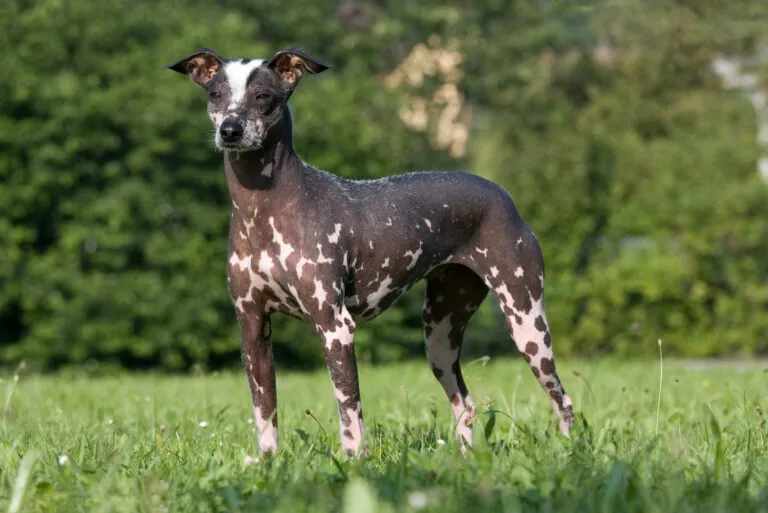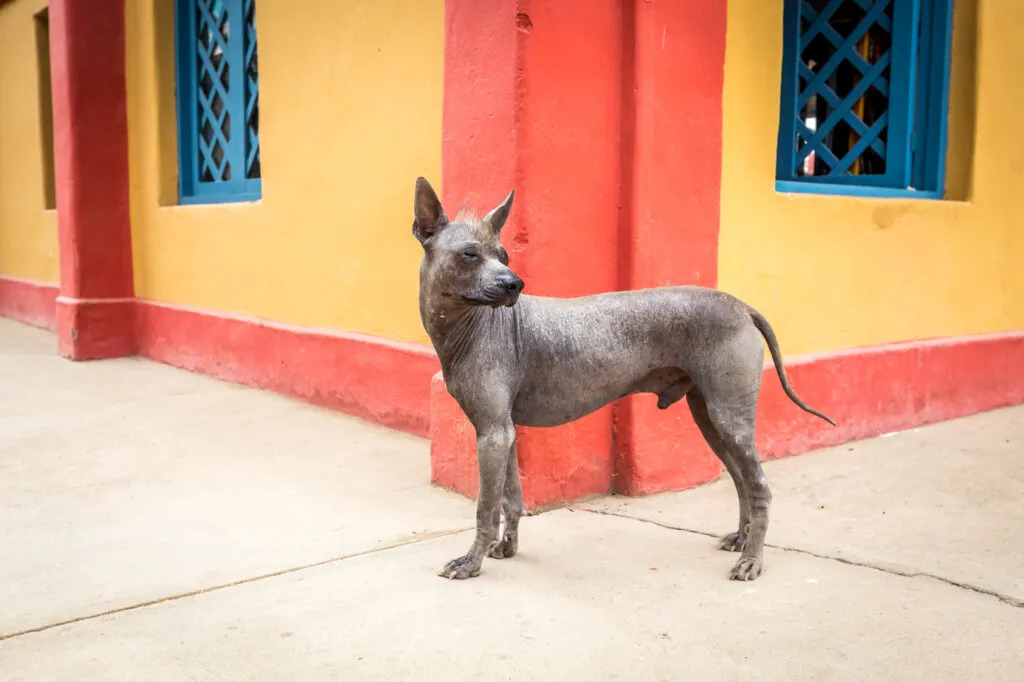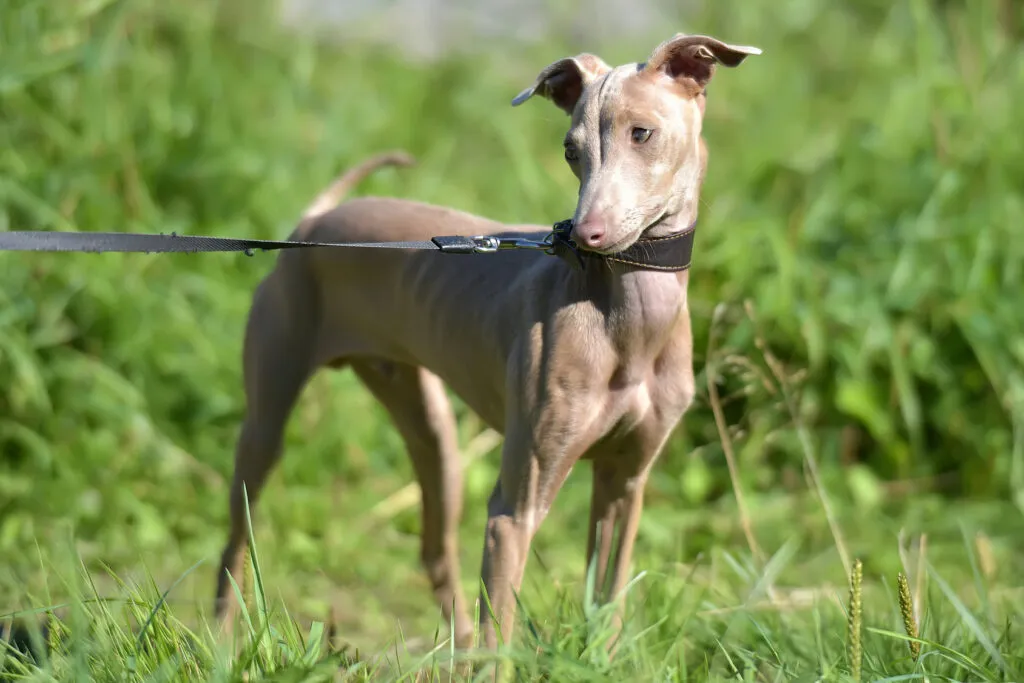Medium Size Poodle
The Peruvian Hairless Dog is divisive: while some dog lovers find its appearance an acquired taste, others rave about its unique look and, not least, the distinctive character of this sociable breed.

© lenkadan / stock.adobe.com
The Peruvian Hairless Dog impresses with its elegant, athletic body and distinctive lack of fur – though haired variants, known as “Peludos,” are also part of the breed standard
The name is fitting: the most noticeable feature of most Peruvian Hairless Dogs is what they lack: fur. However, the breed standard allows for some tufts on its head and rod. The skin can be light or dark, in various shades, either solid or white-spotted.
Not all Hairless Dogs are hairless, as there is also a haired variant: the so-called “Peludos”, which are essential for breeding for health reasons. These account for about one-third of Hairless Dogs.
Since 2013, the haired variants have also been seen at dog shows as they have been added to the breed standard.
Their fur must be short and soft, and all colourings are permitted.
The Peruvian Hairless Dog resembles a greyhound in body structure. This slender dog has large, erect ears that it can lay back when relaxed, a gracefully curved, hanging rod, and an athletic build.
Hairless Dog enthusiasts can choose from three different size variants: the small variant stands 25 to 40cm tall at the shoulder, the medium from 40 to 50cm, and large Peruvian Hairless Dogs measure between 50 and 65cm.
The weight varies accordingly from 4 to 25kg. Only a few hairless dogs have a full jaw, although all representatives of the haired variant usually do.
The exact origin of the Peruvian Hairless Dog, known in its homeland as “Perro sin pelo del Perú,” is unknown. However, its ancestors seem deeply rooted in Peru: depictions on Moche culture vessels show hairless dogs as early as around 750 BC.
Later, these graceful animals were reserved for the wealthy Incas, who ensured they did not mate with other local dogs. It was also the Incas who banned the consumption of dog meat in northern Peru. When the Spanish conquered the land, they discovered many Hairless Dogs among the Incas’ orchids, leading Europeans to call them “flower dogs.”
During the conquest, the breed nearly became extinct, but some specimens survived in remote villages, where inhabitants valued them for their attributed, partly mythical properties: the quadrupeds were believed to have healing effects on certain diseases, such as bone and joint ailments.
In 1985, the Fédération Cynologique Internationale (FCI), the world’s largest dog breeding association, recognised the Peruvian Hairless Dog as a distinct breed. Today, there are officially three hairless dog breeds: the Peruvian Hairless Dog, the Mexican Hairless Dog, also known as “Xoloitzcuintle,” and the Chinese Crested Dog. All three breeds are closely related.
 © nok3709001 / stock.adobe.com
© nok3709001 / stock.adobe.com
Peruvian Hairless Dogs Are Sociable But Independent
The Peruvian Hairless Dog is a friendly, adaptable companion. It prefers being with its human and forms a close bond. Generally, it is very sociable, integrating well into a family and quickly befriending other pets and children.
Many Peruvian Hairless Dogs are known to passionately protect the women and children in their pack. It is important to be cautious during children’s visits to prevent misinterpretations of harmless situations, as the dog may rush to help its two-legged young friend unnecessarily.
Lively and curious, it is a wonderful companion for outdoor activities but remains calm and relaxed at home. It particularly enjoys curling up on its owner’s lap, savouring closeness and warmth. It tends to be aloof and watchful around strangers but not aggressive.
As a primitive dog, the Peruvian Hairless Dog brings some original behaviours into the human-animal relationship. It’s helpful if you already have some dog experience for training purposes, although ambitious novices can also succeed.
Clear rules and consistency are key – as with most dogs. This sensitive dog will only withdraw if treated harshly. Some Peruvian Hairless Dogs can be skittish or fear new situations.
Hence, it’s crucial to socialise them with various situations at a reasonable pace to avoid overwhelming them. Your breeder can offer some tips when purchasing a puppy. Introduce your companion to everyday situations such as train rides, city outings, or home visits early on.
Regular training at a dog school, ideally starting with puppy playgroups, is highly recommended and also enhances the Peruvian Hairless Dog’s social side.
As previously mentioned, a health-related peculiarity must be considered during mating: breeding must regularly include Peludos, the haired variant. This is because the dominant allele for hairlessness only leads to viable embryos when combined with an allele for fur, making heterozygous embryos essential.
Purely hairless embryos are reabsorbed in the womb, making pure breeding for hairlessness impossible, and resulting in occasional haired Hairless Dogs.
Hairless Peruvian dogs usually have incomplete jaws, but this generally doesn’t limit them. For fair-skinned dogs, it’s important at the beginning of summer to gradually accustom them to sun exposure—they tan over time. Sunscreen is also advisable to prevent severe sunburn, especially since these dogs enjoy sunny spots.
In winter, some specimens need weather protection like a dog coat, as they may quickly feel cold during normal walks if not running around. Smaller variants are more sensitive to cold than larger ones.
A Peruvian Hairless Dog can live up to 15 years.
 © Evdoha / stock.adobe.com
© Evdoha / stock.adobe.com
While most Peruvian Hairless Dogs have incomplete jaws, this fortunately doesn’t restrict their diet. You can focus on finding the right food by prioritising what’s crucial for all dogs: high meat content and no grain or sugar. It doesn’t matter whether you choose dry or wet food.
However, wet food is often preferred and contains much more moisture, so dogs don’t need to drink as much to stay hydrated. Ensure your dog maintains a slim waist – if it gains too much weight, reduce daily portions and consider every extra treat.
Size-appropriate dried chews are a good way to satisfy your dog’s chewing needs. Of course, your Peruvian Hairless Dog should always have access to fresh water.
You can leave the comb aside for the hairless variety of this breed. Additionally, you have the advantage of easily spotting parasites on their skin and can apply suitable remedies—from tick tongs to flea treatments—immediately.
Despite this, the Peruvian Hairless Dog still requires regular care. Wash it as needed—some owners recommend weekly—with a sponge and gentle dog shampoo. Some Peruvian Hairless Dogs tend to have dry skin; you can alleviate this with mild, fragrance-free baby moisturisers or olive or coconut oil.
In summer, sunscreen is essential for light-skinned dogs. Trim your dog’s nails if they get too long and clean its ears with a dog ear cleaner if needed.
Lively and full of energy, these dogs love being outdoors and enjoy long walks where they can discover many things. Once fully grown, they make great jogging companions if trained for it. They can also enjoy inline skating, horse riding or cycling at a dog-friendly pace.
The Peruvian Hairless Dog is usually easy to recall and has little hunting instinct.
They aren’t fond of monotonous activities with many repetitions; classical fetching may quickly bore them. Try agility, dog dancing, dog frisbee or teaching them tricks to find what you both enjoy most.
This easy-going breed can bring delight to many dog lovers. They are suitable for apartment living if they get enough exercise and activity. For allergy sufferers they offer a fantastic way to fulfil the dream of having a dog—though you should still discuss this with your doctor and visit the breeder before making a decision to be sure.
They also win the hearts of dog fans who dislike grooming. You can leave the lint brush in the cupboard, making them very low-maintenance in terms of cleanliness. However, owners may need a proverbial “thick skin” when walking a Peruvian Hairless Dog, as the hairless look can sometimes draw criticism.
The Peruvian Hairless Dog fits well into an active family with children, though it is not a fan of hectic environments, which can quickly overwhelm it. If you have small children, provide a retreat for your Peruvian Hairless Dog. It makes a good watchdog by alerting you with barking when strangers approach.
The question of whether the Peruvian Hairless Dog is suitable for beginners can only be partially affirmed. Due to its independence, it can pose challenges for inexperienced dog owners. If you’re considering a Hairless Dog as a first-time owner, make sure to book sessions at a dog school and thoroughly read up on dog training before your new housemate arrives.
With a solid foundation of knowledge, the Hairless Dog will forgive small training mistakes. The breed is not suited for extreme temperatures, particularly cold.
Where Can I Find My Peruvian Hairless Dog?
Peruvian Hairless Dogs are rare in Europe, and breeders are correspondingly scarce. Look for relevant breeding associations in your country for assistance. When seeking a puppy abroad, remember to consider what’s important when adopting foreign-bred puppies.
As a Hairless Dog fan, you may be familiar with the closely related breeds: the Mexican Hairless Dog and the Chinese Crested Dog. One of these may suit you better and be more accessible in your region. Being open to the other two breeds or mixed breeds often leads to finding an older Hairless Dog needing a home.
This usually requires some research. However, nowadays, keywords like “Hairless Dogs in need” often yield results online, leading to adult Hairless Dogs looking for new homes. Try to learn as much as possible about the history of your potential new companion.
We wish you a wonderful time with your unique Peruvian Hairless Dog!
Fans of the Bearded Collie agree that those who aren't familiar with this dog breed simply have to get acquainted with it. And those who have experienced how a Bearded Collie bolts across meadows with its flowing fur, how it rolls around full of energy and joy and how it attentively and observantly takes into account its owners wishes become simply addicted to this original dog breed and its unique charm.
The Goldendoodle isn't a breed, but a pairing between Golden Retrievers and Medium or Standard Poodles. Marketed as a low-maintenance dog for allergy sufferers, this hybrid is enjoying increasing popularity amongst dog lovers, similar to the Labradoodle.